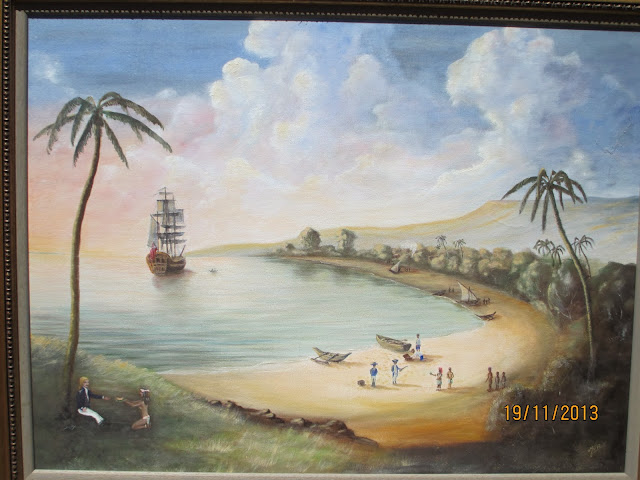William Bligh was appointed as Master of the ship HMS 'Bounty' by the British Admiralty and charged with the task of sailing to the South Seas (South Pacific Ocean) to trade for a ship load of the Breadfruit plant among the islands there. These plants were to be taken to the islands of the West Indies and propagated there to provide a stable source of food for the indigenous and slave populations which worked the sugar and cotton plantations of the era around the 1790's. Bligh was Navy trained and an excellent and very experienced sailor, with iron determination and the capability of succeeding in such a long and dangerous task. A day out of port from England the ship was engulfed in a violent storm and one of the crew was killed, thought to be a bad omen by some of the crew.
'The Omen' –
acrylic 18”x24” MJB
The 'Bounty', after months at sea reached the islands
of the south Pacific and found Breadfruit for trade in the area
around what is now Tahiti. Many of the crew of the 'Bounty' realized
that had found a paradise on earth, some fell in love with the
beautiful native women, and for some time enjoyed an idyllic life
while the Breadfruit was being propagated and put in pots for the
long journey ahead.
'The Savages' –
acrylic 24”x36” MJB
The major difficulty Bligh faced was carrying enough
fresh water on board to keep the Breadfruit plants alive. Much of the
Bounty's course lay through the latitudes 20 to 35 degrees South, a
region of very low rainfall, even out at sea. Such was his
determination that he put the entire crew on a very limited water
ration. This led to disharmony and outright defiance. Bligh responded
with severe punishments for breaches of his orders.
'The Lesson' –
acrylic 18”x24” MJB
Discontent festered, and eventually a mutiny took place
off the island of Tonga led by a reluctant first officer named
Fletcher Christian, who had also fallen in love with a Tahitian
woman. Christian would not allow the crew to put Bligh to death, and
cast him into the ship's longboat and gave each man a choice of
staying with the mutineers on the Bounty or leaving with Bligh in the
longboat. Bligh had 18 men with him in the longboat. He could not
avail himself of any of the islands around Tonga or New Guinea as the
natives were unfriendly and warlike, some being cannibals. He decided
to make for Batavia, a Dutch port in what is now Indonesia, a journey
of some 3000 miles. His remarkable seamanship and iron discipline
enabled him to reach Batavia with minimal loss of life among his
crew.
'The Schism' –
acrylic 24”x36” MJB
Eventually Bligh was restored to Britain and the Royal
Navy sent the HMS 'Pandora' in pursuit of the mutineers, but that is
another story in itself. Bligh was appointed governor of the penal
colony at Port Jackson (Sydney) in Australia, where the military
personnel there had taken over the control of the colony from the
previous governor, and corruption was rife, threatening the colony's
very survival. Bligh's iron discipline may have been seen as what was
needed there.
'The Promotion' –
acrylic 18”x24” MJB
The military corps in Sydney were know as the 'Rum
Corps'. They traded and paid in 'grog' a strong liquor which promoted
corruption, violence and ill-discipline. Bligh set out at once to
break the power of the Rum Corps, which proved to be difficult. The
Rum Corps eventually confined Bligh to 'house arrest'. Bligh demanded
to be released. The Rum Corps put him on a ship bound for England
after making charges against him. He was at the centre of a hearing
which amounted to a struggle for supremacy between the British Navy
and the British Army. The Navy prevailed and Bligh was exonerated of
the charges levelled at him by the Army. He never received another
command.
'The Exoneration' –
acrylic 24”x36” MJB






No comments:
Post a Comment